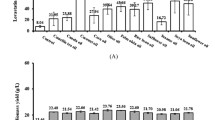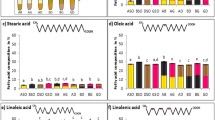Abstract
The enhancing effect of various concentrations of 18 oils and a silicon antifoam agent on erythromycin production by Saccharopolyspora erythraea was evaluated in a complex medium containing soybean flour and dextrin as the main substrates. The oils used consisted of sunflower, pistachio, cottonseed, melon seed, water melon seed, lard, corn, olive, soybean, hazelnut, rapeseed, sesame, shark, safflower, coconut, walnut, black cherry kernel and grape seed oils. The biomass, erythromycin, dextrin and oil concentrations and the pH value were measured. Also, the kinds and frequencies of fatty acids in the oils were determined. The productivity of erythromycin in the oil-containing media was higher than that of the control medium. However, oil was not suitable as a main carbon source for erythromycin production by S. erythraea. The highest titer of erythromycin was produced in medium containing 55 g/l black cherry kernel oil (4.5 g/l). The titers of erythromycin in the other media were also recorded, with this result: black cherry kernel > water melon seed > melon seed > walnut > rapeseed > soybean > (corn = sesame) > (olive = pistachio = lard = sunflower) > (hazelnut = cotton seed) > grape seed > (shark = safflower = coconut). In media containing various oils, the hyphae of S. erythraea were longer and remained in a vegetative form after 8 days, while in the control medium, spores were formed and hyphae were lysed.



Similar content being viewed by others
References
Aftabsavar Y (1994) Distribution of Carcharhinus dussumieri and other prevalent species in Hormozgan state seashore. Oman Sea Fisheries Research Center, Bandar Abbas, p. 23
Anderson RF, Törnqvist EGM, Peterson WH (1956) Effect of oil in pilot plant fermentation. Agric Food Chem 4:556–559
Bellakhdar J, Claisse R, Fleurentin J, Younus C (1991) Repertory of standard herbal drugs in the Moroccan pharmacopoeia. J Entopharmacol 35:123–143
Benslimane C, Lebrihi A, Lounes A, Lefebvre G, Germain P (1995) Influence of dextrin on the assimilation of yeast extract amino acids in culture of Streptomyces ambofaciens producer of spiramycin. Enzyme Microb Technol 17:1003–1013
Bushell ME (1997) Effect of small scale culture vessel type on hyphal fragment size and erythromycin production in Saccharopolyspora erythraea. Biotechnol Lett 19:849–852
Choi DB, Tamura S, Park YS, Okabe M, Seriu Y, Takeda S (1996) Efficient tylosin production from Streptomyces fradiae using rapeseed oil. J Ferment Technol 82:183–186
Choi DB, Park Y, Okabe M (1998) Effects of rapeseed oil on activity of methylmalonyl-CoA carboxyltransferase in culture of Streptomyces fradiae. Biosci Biotechnol Biochem 62:902–906
Clark CJ, Langley D, Bushell ME (1995) Oxygen limitation can induce microbial secondary metabolite formation: investigation with miniature electrodes in shaker and bioreactor culture. Microbiology 141:663–669
Davies JL, Baganz F, Ison AP, Lye GJ (2000) Studies on the interaction of fermentation and microfilteration operations: erythromycin recovery from Saccharopolyspora erythraea fermentation broths. Biotechnol Bioeng 69:429–439
Eiki H, Gushima H, Saito T, Ishida H, Oka Y, Osono T (1998) Product Inhibition and its removal on josamycin fermentation by Sterptomyces narbonensis var. josamyceticus. J Ferment Technol 66:559–565
Hamedi J, Malekzadeh F, Niknam V (2002) Improved production of erythromycin by Saccharopolyspora erythraea by various plant oils. Biotechnol Lett 24:697–700
Hamilton RJ, Hamilton S (1992) Lipid analysis—a practical approach. Oxford University Press, New York, pp 13–64
Hsieh YJ, Kolattukudy PE (1994) Inhibition of erythromycin synthesis by disruption of malonyl-coenzyme A decarboxylase gene eryM in Saccharopolyspora erythraea. J Bacteriol 176:714–724
Hunaiti AR, Kolattukudy PE (1982) Isolation and characterization of an acyl-coenzyme A carboxylase from an erythromycin-producing Streptomyces erythreus. Arch Biochem Biophys 216:362–371
Jones AM, Porter MA (1998) Vegetable oils in fermentation: beneficial effects of low-level supplementation. J Ind Microbiol Biotechnol 21:203–207
Junker B, Mann Z, Gailliot P, Byrne K, Wilson J (1998) Use of soybean oil and ammonium sulfate additions to optimize secondary metabolite production. Biotechnol Bioeng 60:581–588
Lal SD, Lata K (1980) Plants used by Bhat community for regulating fertility. Econ Bot 34:273–275
Lee PC, Loh PC, Ho CC (1997) Production of tylosin by Streptomyces fradiae in palm oil medium. World J Microbiol Biotechnol 13:69–71
Magness JR, Markle GM, Compton CC (1971) Food and feed crops of the United States. (Interregional research project IR-4). N J Agric Exp Stn Bull 828
McDermott JF, Lethbridge G, Bushell ME (1993) Estimation of the kinetic constants and elucidation of trends in growth and erythromycin production in batch and continuous cultures of Saccharopolyspora erythraea using curve-fitting techniques. Enzyme Microb Technol 15:657–663
Melo MLS, Bora P, Narain N (2001) Fatty and amino acids composition of melon (Cucumis melo var. saccharinus) seeds. J Food Compos Anal 14:69–74
Mirjalili N, Zormpaidis VV, Leadly PF, Ison AP (1999) The effect of rapeseed oil uptake on the production of erythromycin and triketide lactone by Saccharopolyspora erythraea. Biotechnol Prog 15:911–918
Pan SC, Bonanno S, Wagman GH (1959) Efficient utilization of fatty oils as energy sources in penicillin fermentation. Appl Microbiol 7:176–180
Park YS, Momose I, Tsunoda K, Okabe M (1994) Enhancement of cephamycin C production using soybean oil as the sole carbon source. Appl Microbiol Biotechnol 40:773–779
Regosz A, Darbrowska D, Babile H, Nestruk H (1982) Methods of determination of erythromycin I. Sci Pharm 50:17–25
Shiring EB, Gottelieb D (1966) Methods for characterization of Streptomyces species. Int J Syst Bacteriol 16:313–340
Pharmacopoeia Convention (2000) The United States Pharmacopoeia, 24th edn. Pharmacopoeial Convention, Rockville, pp 1823–1829
Tsuji K, Goetz JF (1978) High performance liquid chromatographic determination of erythromycin. J Chromatogr 147:302–308
Wardell JN, Stocks SM, Thomas CR, Bushell ME (2002) Decreasing the hyphal branching rate of Saccharopolyspora erythraea NRRL 2338 leads to increased resistance to breakage and increased antibiotic production. Biotechnol Bioeng 78:141–146
Woo WS, Lee EB, Shin KH, Kang SS, Chi HS (1981) A review of research on plants for fertility regulation in Korea. Korean J Phamacogn 12:153–170
Acknowledgements
This research was supported in part by the University of Tehran, grant 513/1/12. We are grateful to the staff of Shafa-e-Sari Antibiotic Producing Co. for their technical assistance.
Author information
Authors and Affiliations
Corresponding author
Rights and permissions
About this article
Cite this article
Hamedi, J., Malekzadeh, F. & Saghafi-nia, A.E. Enhancing of erythromycin production by Saccharopolyspora erythraea with common and uncommon oils. J IND MICROBIOL BIOTECHNOL 31, 447–456 (2004). https://doi.org/10.1007/s10295-004-0166-1
Received:
Accepted:
Published:
Issue Date:
DOI: https://doi.org/10.1007/s10295-004-0166-1




